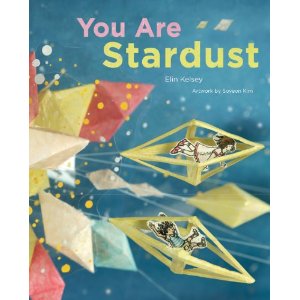Nerd Camp and Twitter
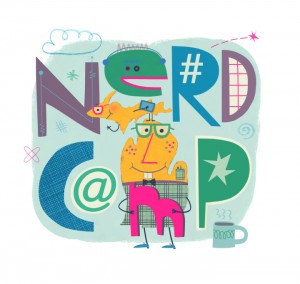 Yesterday I attended nErD Camp, a free, education “unconference” presented by the Nerdy Book Club. For a day and a half, teachers from all over the states came to Parma, Michigan to share ideas about literacy and learning. I led a small session about using public libraries to get kids and teachers the materials they need year-round. I joined sessions on using graphic novels and picture books at all levels and on using Google Docs with forms and add-ins to organize kids’ writing and promote collaboration. (Email me if you want details.)
Yesterday I attended nErD Camp, a free, education “unconference” presented by the Nerdy Book Club. For a day and a half, teachers from all over the states came to Parma, Michigan to share ideas about literacy and learning. I led a small session about using public libraries to get kids and teachers the materials they need year-round. I joined sessions on using graphic novels and picture books at all levels and on using Google Docs with forms and add-ins to organize kids’ writing and promote collaboration. (Email me if you want details.)
Nerd Camp, Jr. was in the evening. Hundreds of kids got to meet authors and illustrators, talk about reading and writing, and score free books. Matt Faulkner, Ruth McNally Barshaw, Linda Urban, Laurie Keller, and others wowed the crowd. (Laurie Keller designed the Nerd Camp logo. Isn’t it fantastic?)
My brain is spinning with new ideas and my appreciation for teachers is even greater than it was before. In July, when most teachers are finally able to enjoy a break, these folks came for a professional development event and generously shared what they knew. I am inspired by you all. Thanks to Colby and Alainna Sharp, Donalyn Miller, Kristin McIlhagga, and the entire Nerdy Book Club powerhouse. nErD Camp 2015 is already in the works if you want in on the fun.
And thank you, Nerds, for pulling me into the world of Twitter! You can follow me @RemenarReads. I promise to tweet only about literacy and books (saving my crazy cat photos for Facebook).
Read MoreYou Are Stardust
Happy July! This is the month for fireworks and stargazing and wonder, which makes it the perfect month for You Are Stardust written by Elin Kelsey with artwork by Soyeon Kim. It begins like this:
“You are stardust./
Every tiny atom in your body came from a star that exploded long before you were born.”
This informational science book reads like poetry, and the facts within will astound your students:
We breathe in more than a million pollen grains with each breath.
The water we drink today is the same water that filled puddles when dinosaurs walked the Earth.
The electricity in your brain is stronger than lightning.
On owlkidsbooks.com, you’ll find a free teacher’s guide, a link to the app, a video showing second graders discussing the book’s themes, and a video that I found fascinating on how the book was made. Soyeon Kim’s dioramas are awesome and will inspire your kids to get out the art supplies. Choose an incredible fact from the book or one from the world that amazes you and bring it to life with a 3-D diorama. You might even ask a friendly librarian at your local library to put your diorama on display. (I know I’d say yes!) I hope that you and your students can be awed like Elin Kelsey and Soyeon Kim were and find beauty in our connections to the natural world.
Read MoreDig in to fun summer books!
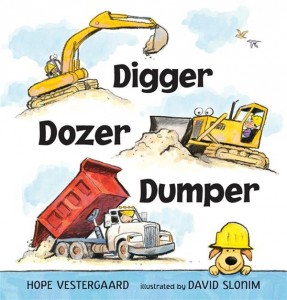
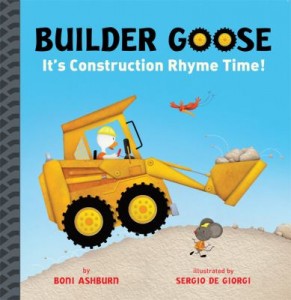 These books are so much fun I couldn’t choose just one! Now that summer is here, I’m looking for books that encourage outdoor play. Here are two books that will have kids scurrying to the sandbox: Digger, Dozer, Dumper written by Hope Vestergaard and illustrated by David Slonim and Builder Goose: It’s Construction Rhyme Time! by Boni Ashburn and illustrated by Sergio de Giorgi.
These books are so much fun I couldn’t choose just one! Now that summer is here, I’m looking for books that encourage outdoor play. Here are two books that will have kids scurrying to the sandbox: Digger, Dozer, Dumper written by Hope Vestergaard and illustrated by David Slonim and Builder Goose: It’s Construction Rhyme Time! by Boni Ashburn and illustrated by Sergio de Giorgi.
Both of these books have poems about construction vehicles, so by sharing them together you’ll not only hit Range of Reading, you’ll have great compare/contrast discussions which hit Integration of Knowledge & Ideas. (Also, both are written by Michigan authors, so shout out to the proud Mitten State!) I love that these books both give real information about how these machines work within fun, catchy poems. Dig these favorites:
Backhoe (from Digger, Dozer, Dumper)
The backhoe’s two machines in one:
a useful little truck.
His front end pushes dirt and rocks:
his back end digs out muck.
Heave Ho! Let’s Go! (from Builder Goose)
This old crane,
it swings wide!
It takes pallets for a ride.
With a heave ho, let’s go,
swing it back for more.
Hoist it high and watch it soar!
Once you and your crew have enjoyed the construction poems, everyone will want to go dig in the sandbox and build, dig, measure, and pour. Extend the learning and develop fine motor skills with these fun activities I found on preschoolexpress.com, Jean Warren’s genius website: hammer golf tees into firm Styrofoam pieces, screw screws into bars of soap, and build edible structures with graham crackers and frosting, peanut butter, or cream cheese. Happy reading!
Read More
“Rah, Rah, Radishes” and Go, STEM!
 Happy May, everyone! I had the pleasure of speaking at an early education conference where our theme was literacy and science. I brought stacks of books that tie into STEM (Science, Technology, Engineering, Mathematics) or STEAM (add Art) to share. Rather than just lecture all day, I led a session of “speed-dating” books: we’d spend a few minutes skimming a book and brainstorming ways to use it with students, share our ideas with the group, and pass the book along. This way, we had time to get our hands on over a dozen books and walk away with practical classroom applications. I was so inspired by the fantastic ideas the teachers generated! Here are a few ideas we came up with after reading Rah,Rah, Radishes! A Vegetable Chant by April Pulley Sayre:
Happy May, everyone! I had the pleasure of speaking at an early education conference where our theme was literacy and science. I brought stacks of books that tie into STEM (Science, Technology, Engineering, Mathematics) or STEAM (add Art) to share. Rather than just lecture all day, I led a session of “speed-dating” books: we’d spend a few minutes skimming a book and brainstorming ways to use it with students, share our ideas with the group, and pass the book along. This way, we had time to get our hands on over a dozen books and walk away with practical classroom applications. I was so inspired by the fantastic ideas the teachers generated! Here are a few ideas we came up with after reading Rah,Rah, Radishes! A Vegetable Chant by April Pulley Sayre:
Bring in vegetables found in the book. Sort the vegetables by color and by size.
Classify and sort vegetables by the parts we eat: root vegetables, leaves, etc. Read Tops and Bottoms by Janet Stevens as a tie-in text and talk about which vegetables would be “tops” or “bottoms” according to Hare.
Predict which vegetables will sink or float. Test predictions in a tub of water. Wash the vegetables and talk about textures.
Use the vegetables to make prints.
Compare and contrast with fruits.
Weigh and measure the vegetables. Use a vegetable as a measuring tool.
Take photos of vegetables and label them. Reread the book and have students hold up the corresponding photos.
Make a chart or a Venn diagram with the terms “raw” and “cooked”. Try some vegetables both ways and chart our preferences.
See what other vegetables besides potatoes can be delicious mashed (great for little ones to do the mashing!)
Bring in potatoes with “eyes” sprouting and bring in vegetable seeds. Compare seeds and sprouts, then plant!
Make an edible collage with vegetables.
Practice patterning skills like ABAB, etc. with bite-size veggies and eat when done.
Plan a field trip to a farmer’s market or invite a farmer to come to the classroom for more vegetable experiences.
If you’re interested in the list of science books I shared, please email me at kristenremenar AT gmail DOT com. If you like Rah, Rah, Radishes! A Vegetable Chant, be sure to check out Go, Go, Grapes! A Fruit Chant and Let’s Go Nuts! Seeds We Eat also by April Pulley Sayre. Hooray for early science!
Read MoreBananas for Early Readers!
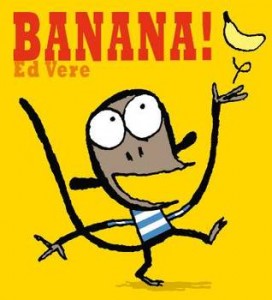 Happy April, everyone! A teacher-friend asked me for super-simple books for readers who are wrestling with her lowest-leveled texts. I shared BANANA! by Ed Vere and the kids went ape. The facial expressions on the two monkeys are so engaging, and the text is limited to two words: “banana” and “please” with either question marks or exclamation points. As I read, I pointed out how the exclamation mark and question mark change the way we read the words. (Print Concepts mini-lesson? Check!)
Happy April, everyone! A teacher-friend asked me for super-simple books for readers who are wrestling with her lowest-leveled texts. I shared BANANA! by Ed Vere and the kids went ape. The facial expressions on the two monkeys are so engaging, and the text is limited to two words: “banana” and “please” with either question marks or exclamation points. As I read, I pointed out how the exclamation mark and question mark change the way we read the words. (Print Concepts mini-lesson? Check!)
Banana! is perfect for readers’ theater. After reading the book to your students, split them into pairs. The kids can make their own monkey masks or hats or puppets. Give students time to practice their lines (nailing that Common Core State Standard of Fluency). Then, kids take turns performing for the class, reading their lines as you hold up the book and turn the pages.
You can make a silly spin-off book called “Apple!” Take photos of two teachers arguing over who gets to eat the apple and lay them out like Ed Vere’s pages. You can make lots of little class books like this if you have a digital camera – let your students be the stars of the book, arguing over and eventually sharing an orange, or a pencil, etc. Your students will go, well, bananas for this book!
I’ll be in Elizabeth, New Jersey this month to talk about the best books to teach preschool and kindergarden reading standards. Next month, I’m the keynote speaker for an early literacy conference in Michigan and I have two presentations to public librarians on Common Core State Standards. Please keep your fingers crossed for ice-storm-free travel days!
Read More
Here Come the Humpbacks!
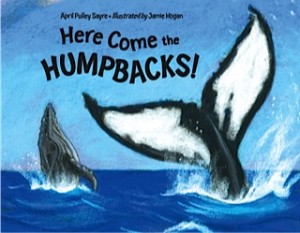 Happy March, everyone! This month I’m sharing a terrific informational picture book about humpback whales and a fabulous, free activity guide that will have your students up and moving as they process information. For those Nature Smart students who’re fighting the winter blahs, this kind of reading will be especially meaningful.
Happy March, everyone! This month I’m sharing a terrific informational picture book about humpback whales and a fabulous, free activity guide that will have your students up and moving as they process information. For those Nature Smart students who’re fighting the winter blahs, this kind of reading will be especially meaningful.
Here Come the Humpbacks! written by April Pulley Sayre and illustrated by Jamie Hogan is a nonfiction book detailing the migration of a humpback whale calf. Sayre gives us all the excitement of the treacherous journey that spans over 1,500 miles and doesn’t skimp on rich vocabulary or solid information.
After reading the book, your students can review what they’ve learned and “act out” the migration of a humpback. (Go, Key Ideas & Details!) Curious City has a wonderful, free humpback migration game you can download with step-by-step instructions and printables for 10 stations for students to visit. To add another layer of fun, go to YouTube and let kids hear the sounds that humpback whales make. (For more information about Curious City and its free children’s book engagement materials as well as book giveaways, please visit: curiouscitydpw.com. You’ll thank me later.)
I’ll be in New Jersey in April giving a seminar on early literacy skills for preschoolers and kindergartners. Please keep your fingers crossed that we’ll be enjoying tulip blossoms and not ice storms!
For more information about the author, please visit: aprilsayre.com.
For more information about the illustrator, please visit: jamiehogan.com
Read More
Battle Bunny
 Happy February! This time last year, I was celebrating the sale of my first picture book, GROUNDHOG’S DILEMMA, to Charlesbridge. This February 2nd, I came home from a week of presenting seminars to a cool surprise: my husband (author/illustrator Matt Faulkner) just received the official layout of the book so he can begin making the art! Woohoo!
Happy February! This time last year, I was celebrating the sale of my first picture book, GROUNDHOG’S DILEMMA, to Charlesbridge. This February 2nd, I came home from a week of presenting seminars to a cool surprise: my husband (author/illustrator Matt Faulkner) just received the official layout of the book so he can begin making the art! Woohoo!
Of course, I won’t see any of the art until it’s passed my editor’s approval. In the publishing world, authors don’t get to communicate with the illustrators. I just happen to live with my illustrator. And because I’d like to continue living with him, I can’t watch over his shoulder as he draws my characters, because I’d be tempted to give helpful comments like, “Maybe his cheeks should be a little chubbier, and maybe you should….” So Matt will make his magic in his studio and I will try not to peek until my editor says I can!
Those of you came to my seminars last week have already seen my new favorite book: Battle Bunny written by Jon Scieszka and Mac Barnett (and Alex) with pictures by Matthew Myers (and Alex). Kids who love the humor of Captain Underpants will go nuts for this book, and you can use it to teach the Core Standard of Craft & Structure.
When you show students the cover, they might think this book has been defaced. Well, yes and no. Battle Bunny is supposed to look drawn on and scribbled over – that’s the brilliant premise of this book. A kid named Alex is supposedly given a sappy-sweet book called “Birthday Bunny” from his Gran-Gran. Alex transforms the book by crossing out words, writing his own words, and adding crazy details to the pictures. For instance, the line “Birthday Bunny started on his path, hopping through the trees” is rewritten as “Battle Bunny started on his Evil Plan, chopping through the trees” and we see the cute birdie in the tree now has a speech balloon saying “You will fail!”
Revising! Editing! Transformative writing! After you’ve talked with your students about the authors’ and illustrator’s craft of word choice, art design, etc. that add layers to the book, go to mybirthdaybunny.com. There’s a free lesson plan for teachers, and I love that you can print off the “original” sweet version of the story for kids to change. If you are super-brave, buy some beat-up books from the library’s used book sale or from a thrift store and let your students revise them. Just make it clear which books can be written in and which of your books are off-limits!
Read More



